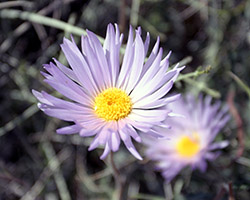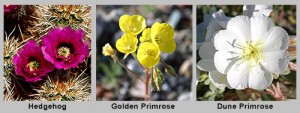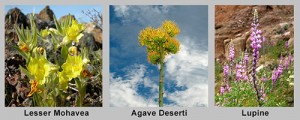Mojave Desert Wildflowers
We’ve all heard the expression “April showers bring May flowers” but that concept doesn’t usually hold true here in our desert. By May, it’s too hot for wildflowers!
One of the many great reasons for exploring our Mojave Desert is to enjoy the dazzling springtime display of wildflowers. Many people have heard of these wildflower displays but most of them don’t know when or where these displays are. And, when they do find them, people often wonder what type of flower they are looking at. Is that a daisy? Or is it an aster? It looks kind of like a sunflower but is it?

Mojave Aster

Destination: Wildflowers
Although our post isn’t a trip to any one destination like our other posts, it will give you an idea of where to find wildflowers around the Mojave Desert. It will also give you not only information about wildflowers but also a brief introduction to the complex world of desert flora. So, before we talk about wildflowers, let’s talk a little bit about plants in general.
In addition to the wildflowers, the Mojave Desert is home to several hundred different types of plants, many of which produce showy and colorful blooms. Plants can range in size from tiny, ground-growing members of the Phlox plant family that are no more than two inches high to the tall, iconic Joshua Tree which is a type of yucca that belongs to the agave family.
The Mojave Desert has one of the largest diversity of plants found in all of North America, second only to the Sonoran Desert. It is a little-known fact that, San Bernardino County’s own remote Kingston Mountains, north of Baker, is the most botanical diverse area in all of California with over 500 different plant species!
Both the Mojave National Preserve, Death Valley and Joshua Tree National Park are great destinations if you are looking for a diversity of wildflowers as well as plants in general. Each park has a variety of soils, terrain and altitudes that create ideal growing conditions for many different types of plants.
Life Zones
The combination of soils, altitudes and other conditions, such as average rainfall and temperatures, create individual growing environments or zones that botanists call “life zones”. For example, in the “Desert Wash” life zone there is an increased amount of ground water available to plants. These zones are also typically in lower altitudes so there is more air for certain plants to breathe. In contrast, the “Joshua Tree Woodland” life zone is at a higher altitude where there is less water and less air available for plants. Each of these life zones grow very different types of plants because of their different environmental conditions. To see what the different life zones look like, be sure to watch our YouTube video located further down this post.
When it comes to the question of “when do wildflowers bloom”, the answer is….it depends. In general, wildflowers tend to “follow the warmth”. Plants growing at lower altitudes bloom earlier in the season, like February and March, because the desert warms up there first. As the days get warmer, you can watch as the wildflower blooms creep up the hillsides to higher elevations well into May and June.
The Mojave Desert, because of its many types of terrain, has many different elevations making it an ideal place to find wildflowers no matter what springtime month you go. So, if you’re heading out to look for wildflowers, we suggest that you plan ahead and consider the time of year and how warm it has been. Then head for an elevation that is appropriate and you’ll increase your odds of finding those elusive wildflowers.
More…
The Right Conditions
When it comes to wildflowers, the single most important factor that determines whether or not there will be a wildflower bloom is the amount and timing of rainfall. If the Mojave Desert experiences a long, soaking rainfall sometime in the months of November to January, then chances are very good that there will be a sizable wildflower bloom. If the desert gets good rainfall in other months, then only certain plants will benefit and there will be only a meager wildflower display that year. Even if the desert gets the right amount of rainfall at the right time, a cold snap in March can kill off many of the fledgling plants resulting in a poor wildflower showing. So, as you can see, conditions have to be just right to get those dazzling displays. All the more reason to get out there and appreciate them when they do happen!
When we do get those perfect conditions, there are various places around the Mojave to look for wildflowers. For those of us who live in the desert regions, our first clue that the wildflower bloom has begun are the many yellow flowers blooming in open fields. So be on the lookout. Once you see them, there is typically a 2 – 4 week window of time where you have a good chance of finding a dazzling wildflower bloom within a 1 – 3 hour drive from your home, providing you live in Southern California.
For those of us that live in the urban areas of Southern California, such as the L.A. Basin or San Diego, be on the lookout in open and undeveloped open areas for wild plants that are blooming. This is also an indication that somewhere out in the nearby desert, a wildflower bloom is in progress. However, depending on which urban area you live in, by the time you notice flowers growing it may be too late to enjoy a desert wildflower bloom.
Identifying Flowers & Plants
Identifying the different wildflowers can be tricky. Plants are first categorized into families. Some examples of families are sunflower, pea (bean or Fabaccae), mallow, cactus (Cactaceae), primrose, etc. Within the sunflower family are plant species like the Mojave aster, brittlebush, gravel ghost, etc. Flowers from this family typically look like a classic sunflower, having a central disk with peddles extending out.
Within the cactus family are plant species including beavertail, buckhorn cholla, California barrel, hedgehog, etc. and we all know what cactus looks like! But don’t let all these names scare you. You don’t have to know the name of something to appreciate and enjoy the beauty of it.
We realize that it is difficult to visualize the different flowers, life zones and other factors mentioned in this article, so we have developed an accompanying YouTube video presentation for you. It will show examples of some of the Mojave Desert’s life zones, as well as a smattering of the flowers that grow there. Scroll up to locate the video.
Botany is a whopper of a subject. After learning a few of the basic classifications of plants, you can easily become more knowledgeable than the average person! Knowing the environments and life zones of where different plants grow and when they bloom will help you expect what to find in different locations.
Learn More
Along with the guides from Amazon.com listed above, we offer two eBook travel guides (we call them Virtual Tour Guides) that cover the Mojave Desert region. Each guide has a comprehensive section on plants. It explains life zones and botany in more detail.
In each guide, the section that covers flora explains many of the plants and flowers that you will find in the Mojave Desert. Covered are the plant’s characteristics, such as botanical name, blooming months, plant size and more. Included are many pictures of each plant, both blooming and not blooming, so that you can identify it in nature. There is also a list of plants organized by flower color for easy identification.
Support Us
Help us fill up our tank with gas for our next trip by donating $5 and we’ll bring you back more quality virtual tours of our trips!
Your credit card payment is safe and easy using PayPal. Click the [Donate] button to get started:


